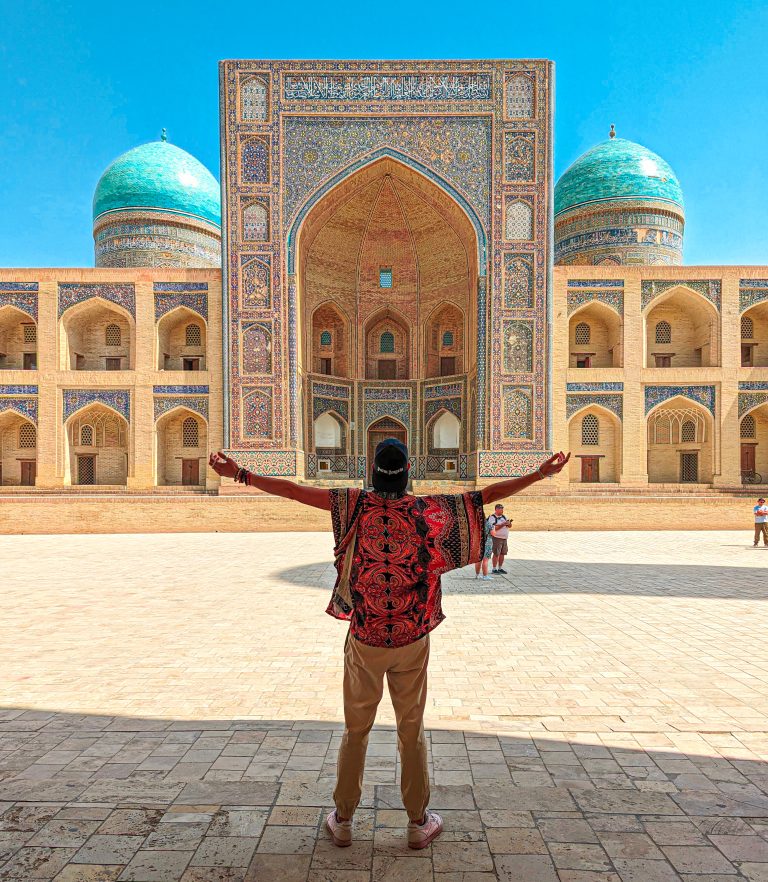Ultimate backpacking guide for Egypt
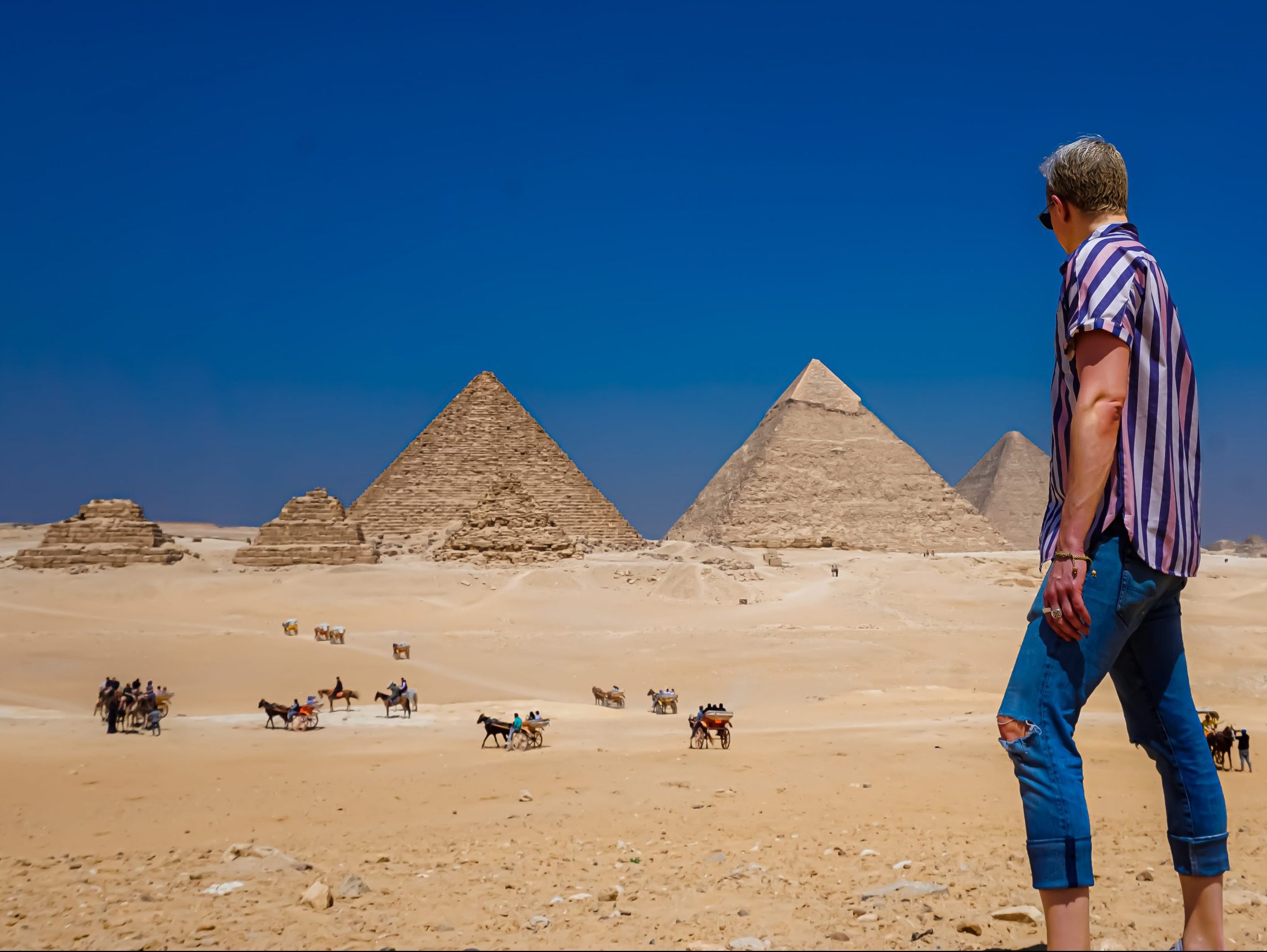
Egypt is one of the oldest civilizations in history. Its origins date back to 3,000 BC. Through this trip you will visit temples that are more than 4,000 years old, the pyramids of Giza, the only wonder of the ancient world that still exists, you will cross the Nile, the second largest river in the world and probably one of the most iconic in the world.
You will discover the most ideal places to meet local people where you can learn about their culture and I will show you the places you should not miss with a traveling community eager to learn and discover about Egyptian culture and traditions.
Everything you need to know for your trip to Egypt:
- Best time of year to visit Egypt
- Best tips for visiting Egypt
- 12-Day itinerary in Egypt
- Daily budget for backpacking Egypt
- Where to stay in Egypt
- What to do in Egypt if you have more time
Official exchange rate 1EUR = 18.65LE
Best time of year to visit Egypt
Egypt has two times of the year, (funny mode ON) the time of year that is hot and the time that is wayyyyy too hot.
- Winter: Due to its location it does not last for a long time, very dry with temperatures around 20ºC. Wetter climate in the Alexandria region with more Mediterranean temperatures.
- Spring – Autumn: Between March and April in the first part of the year and November, they are usually the bridging climate between summer and winter, although you can get surprises as was my case with days with temperatures above 42ºC.
- Summer: It lasts for almost 6 months, average temperatures around 40ºC in Luxor and Aswan and around 35ºC in Cairo. More relaxed climate in coastal areas, especially in the Sinai peninsula due to its strong winds.
Best tips for visiting Egypt
- Uber: Avoid taxis in the big cities, Aswan, Luxor and Cairo. You will know what you pay from start to finish and believe me this is appreciated in Egypt. If you go by taxi make sure you have a meter or agree on the price in advance for the journey and make it clear if it is per group or person. (All or all together in Arabic is pronounced: Ass)
- Negotiate: Never accept a price directly in a store, if they ask you for 100 LE, offer 10 LE until you reach a price that you consider appropriate.
- Water: The big bottles are worth 5 LE and the small ones 3 LE, they were fooling me the first three days. You should always carry a bottle with you, the climate is very dry and the temperatures very high and you run the risk of dehydration. To give you an example in Luxor I drank 6 liters a day and only went to the toilet once.
- Do not be overwhelmed: The locals can become very persistent, especially in tourist places, so that they act as a guide or enter their store. The magic words (sorry for misspelled it !, but they sound more or less like this): La’a Shukran, No no thanks or Mafis felus, I have no money, they usually serve to get rid of them.
- Avoid animals in tourist places: Camels, horses, donkeys and carriages, it does not matter where you go, but they are usually mistreated and are seen very poorly fed. Avoid this type of tourism.
- Student card: Do not leave it at home, temples and museums will be half price, if you do not take it with you, try with the transport card of your country, it usually sneaks.
- Four words in Arabic: As you have already seen in previous lines either out of respect: Salam Aleikum, hello or good morning or Shukran (I don’t really know how to spell it) to say thank you, knowing four words in the local language is always good to move around a foreign country.
12-Day itinerary in Egypt
Your arrival in Egypt will probably be through Cairo International Airport. As soon as you arrive, I recommend that you get a prepaid SIM card at the baggage claim terminal, even though I used Vodafone, everyone recommends Etisalat and the coverage is better. It is more than likely that the suitcases take a long time to appear so you have plenty of time to get your Egyptian number.
When you go out, the taxi drivers will start to harass you, just tell them that you already have transport that a friend of yours comes to look for you and that’s it. My recommendation is that you use Uber, it is very cheap, safe and you always know what you pay without surprise. They can pick you up leaving the terminal going down the stairs in the parking lot. For about 80-100LE you should reach the center of Cairo.
Days 1 and 2: Cairo
Cairo has a particular charm that no other city has, it is a chaotic city of 20 million people in its metropolitan area. Noisy, stressful, chaotic and quite dirty, but it is worth spending a couple of days at least to get lost in its bazaars, streets and mosques.
We start in a big way with a visit to the Pyramids of Giza, contrary to what you might think they are very close to the center of Cairo, you should arrive in just 30 minutes and 80 LE depending on the traffic. A little less than 15 minutes after arriving you will begin to dissipate them on the horizon, I personally was speechless and I consider it one of the most spectacular architectural wonders I have seen in my life. I was in the complex for about 4 hours and I couldn’t stop looking at them and taking photos of them.





The entrance fee is 200 LE to enter the complex and from there you pay supplements depending on where you want to enter. The Pyramid of Kheops costs 400 LE, a bit expensive, I understand that the one in Saqqara is better and costs only 150 LE. Do not imagine large labyrinths as in the movies or the drawings, they are practically all stone except for a narrow corridor that leads to the interior of the burial chamber. I recommend that you go early to avoid the desert heat and spend several hours walking around the complex. In this same there is also the Sphinx, very small compared to what you can imagine.
The Pyramids of Giza are an intense visit, in the afternoon I went to Khan El-Khalili, it is the old souk of Cairo. Forget that no guide wants to take you somewhere else, this is the true essence. Stores of fabrics, toys, metals, pots, spices and shops of all kinds scattered along small alleys through the center of the city. You will find mosques and temples everywhere between them. You should not miss Al-Azhar Mosque, Al-Hussain Mosque and Sultan Al-Mu´ayyad Mosque. You may not be able to enter all of them.
The second day I dedicated myself to visiting Saqqara, architecturally less spectacular than Giza, even so this was the beginning of the pyramids and the Step Pyramid of Saqqara or Pyramid of Djoser was the first to be built in Egypt. What began as a single-level rectangular plan became a 9-storey construction that would end up being the first pyramid in Egypt, its architect was Imhotep and he built it for King Djoser.





Here you will hardly find tourists, it is extremely quiet and it is a pleasure to visit, since there is no one trying to sell you anything. Although to visit it like the rest of the Memphis necropolis it is recommended that you use a private driver, since it is difficult to get around here by Uber. This was my biggest mistake and it took almost an hour to find transportation back to downtown Cairo. The adult ticket is 180 LE.
Days 3 and 4: Aswan
You have several options to get to Aswan from Cairo. The slowest, most interesting, economical and time-efficient is the night train. Despite what they may tell you, it is very cheap and you just have to go to the Ramses II station to buy your tickets or simply register and do it at the official website of Egyptian National Railways. It is very counterintuitive, comment or write me a message and I’ll give you a cable. The night ticket costs 180 LE, which is super cheap, but keep in mind that you will be 13-14 hours on the train.
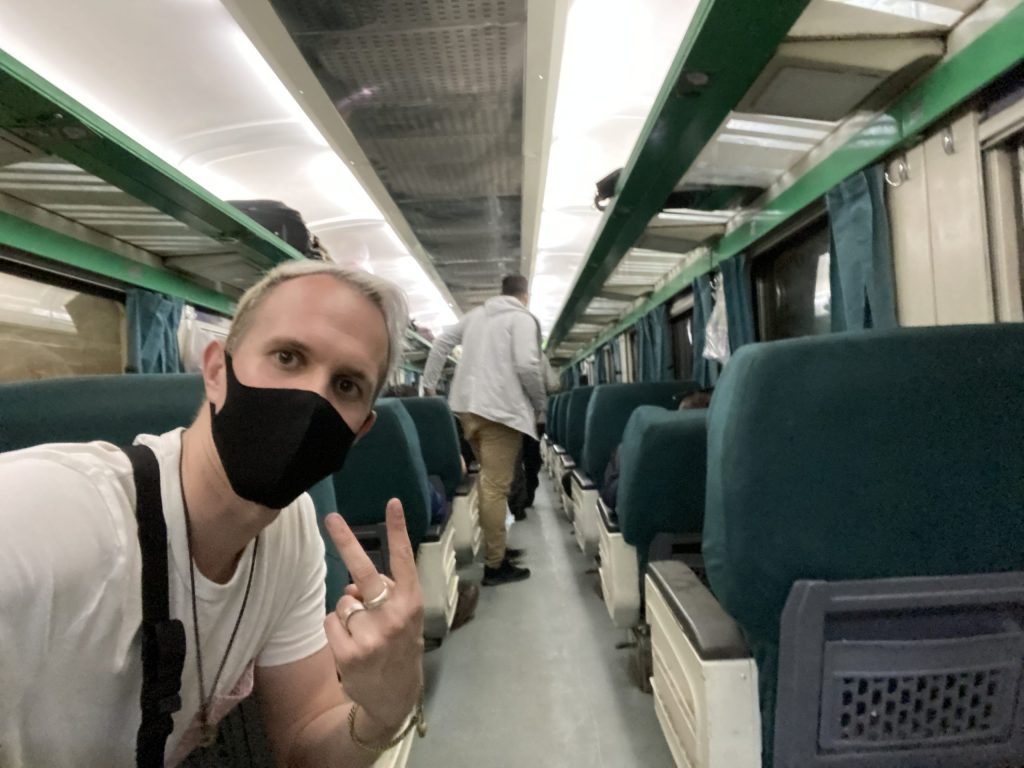
Once in Aswan I recommend that you stay in Elephantine, forget about any other part of the city. Look for a guesthouse, there are them of all prices, the island is the origin of the history of the Nubian civilization and has a unique charm. The ferry costs LE 5 per way per person.
There are many things to do around Aswan and Elephantine, in my case as I arrived I met a Spaniard with whom I went to have breakfast at 12 noon. After breakfast / lunch a nice Nubian man crossed us to the other side of the Nile (westbank) for 20 LE each later he would pick us up a little further north for about 25 LE back to the guesthouse.
We spent a few hours visiting the western part of Aswan, walking through the dunes and its arid mountains. There you can see from the outside but not visit the Aga Khan Mausoleum and the St Hedra Monastery from the inside. A little further on you will find the Monastery of Saint Simon, in my opinion a marvel, it is practically destroyed on the inside although it preserves its structure to perfection, the entrance is 20 LE. There we met the Monastery guards, with whom we were having tea with their AK47s … We continued our ¨hard journey¨ through the desert towards the tombs of the Nobles, we arrived super dehydrated since to make less turn we decided to cross by climbing the dunes (not a good idea). Although the graves deserved it well and once there we recovered quickly.





We ended up closing the day with a swim in the Nile (which by the way the water is frozen), with a few beers in what is probably one of the best rooftops in the entire Nile (Bob Marley Hostel) and having a typical Nubian dinner with others. travelers on Seko Kato.
The second day in Aswan was a transition day, half of the guests were leaving and half were still, so with a group of French we went to the Temple of Philae (French was my second language on this trip, the 50 % of travelers I met were French).
To give a bit of context the temple of Philae is located 15 minutes from the center of Aswan between two dams north of Lake Nasser. The temple is not in its original place and it is that it was disassembled piece by piece and rebuilt in its current location. This is due to the fact that with the construction of the dams the water level rose and to prevent it from ending up at the bottom of the swamp the location was changed. The entrance fee is 180 LE, it is worth your visit, although you must visit it with a boat and they usually charge about 300 LE per boat, I recommend that you get together with someone to make the visit.
The Temple of Philae is spectacular, its hieroglyphs are in perfect condition, the statues and columns have stood the test of time without practically eroding.
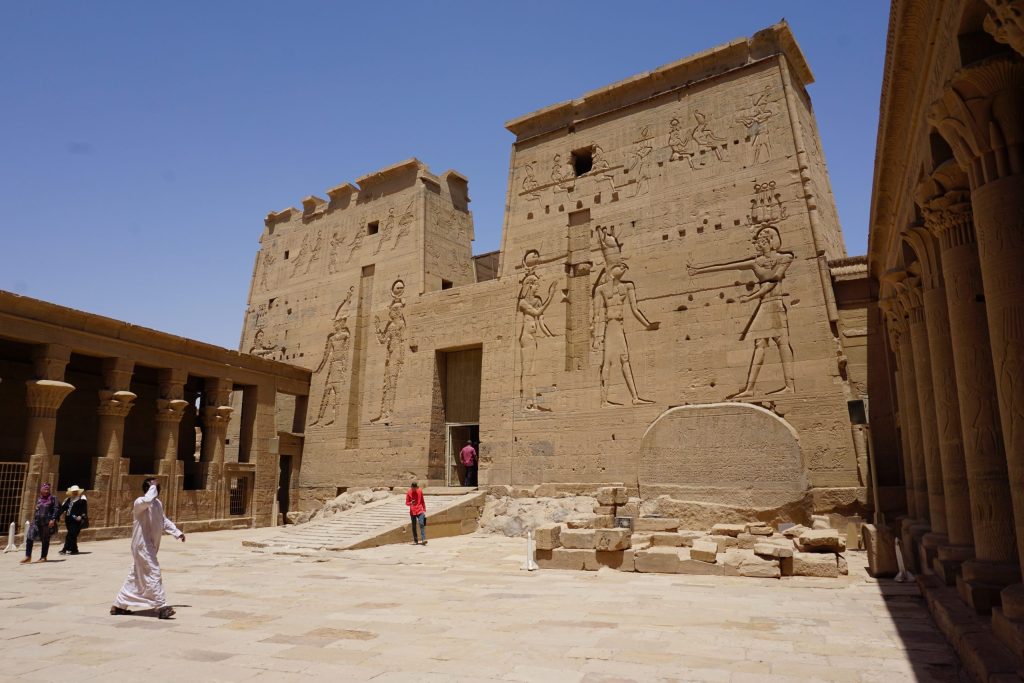
After returning to the hostel and resting a little, I went to the center of Aswan to visit its Zouk and center, although from my point of view it does not have much attraction. There are many more places to visit in Aswan that I did not go to, such as the Nubian Museum and the Unfinished Obelisk.
That same night I met two people who would accompany me during the middle of my adventure without whom the trip would not have been the same with those of us who decided to go together to Abu Simbel the next day.
Day 5: Abu Simbel
To get to Abu Simbel on your own you will have to take a bus that leaves at 8am and takes about 4:30 hours, this leaves from the bus terminal to the north of Aswan, you can take a minivan for 2 LE to get there. The price of the bus to Abu Simbel 80 LE. The journey has its grace because you stop at different police checkpoints, service stations etc … All very authentic to be honest, although it is a bit long. An Egyptian taught us the numbers in Arabic so that we would not be misled in the shops. Good advice to know the numbers and four words in Arabic.
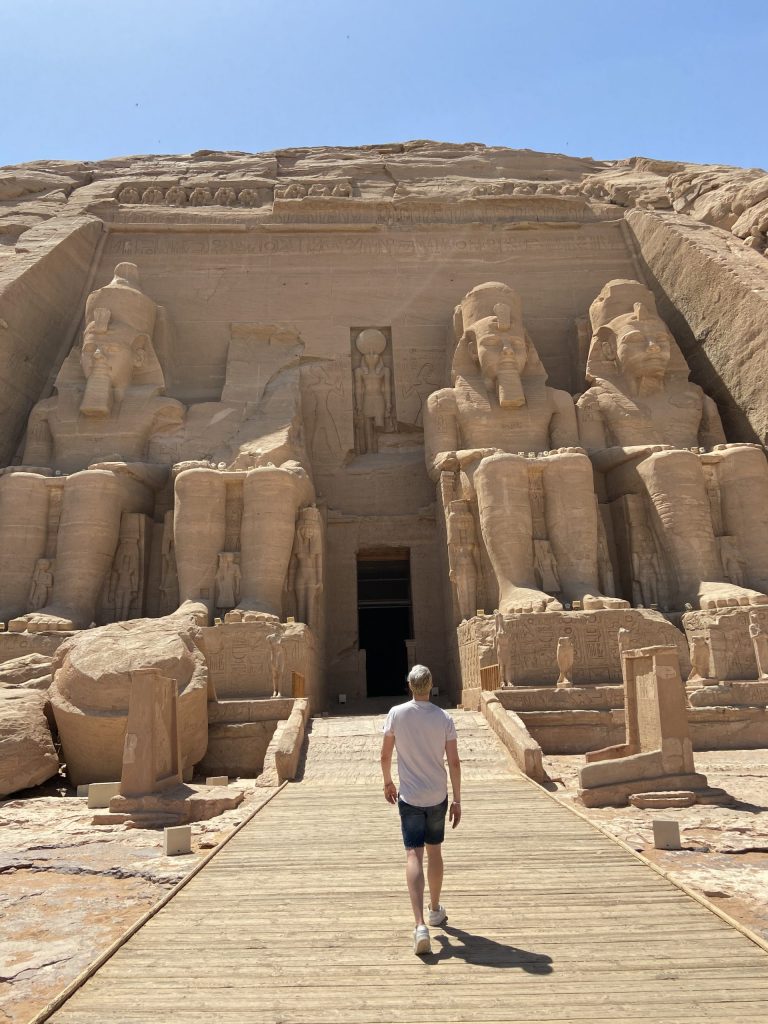
The bus stops in the city of Abu Simbel where there is nothing to do but see the temple, you will have to take a Tuk-Tuk to get to it. The entrance is 250 LE and it is probably the most spectacular temple you will see in Egypt, the majestic sculptures of more than 30 meters high will take your breath away. Like Philae the temple was moved when the Lake Nasser dam was built.
We stayed for lunch in the city and later we took a minivan back to Aswan, we wanted to hitchhike back but nobody stopped.
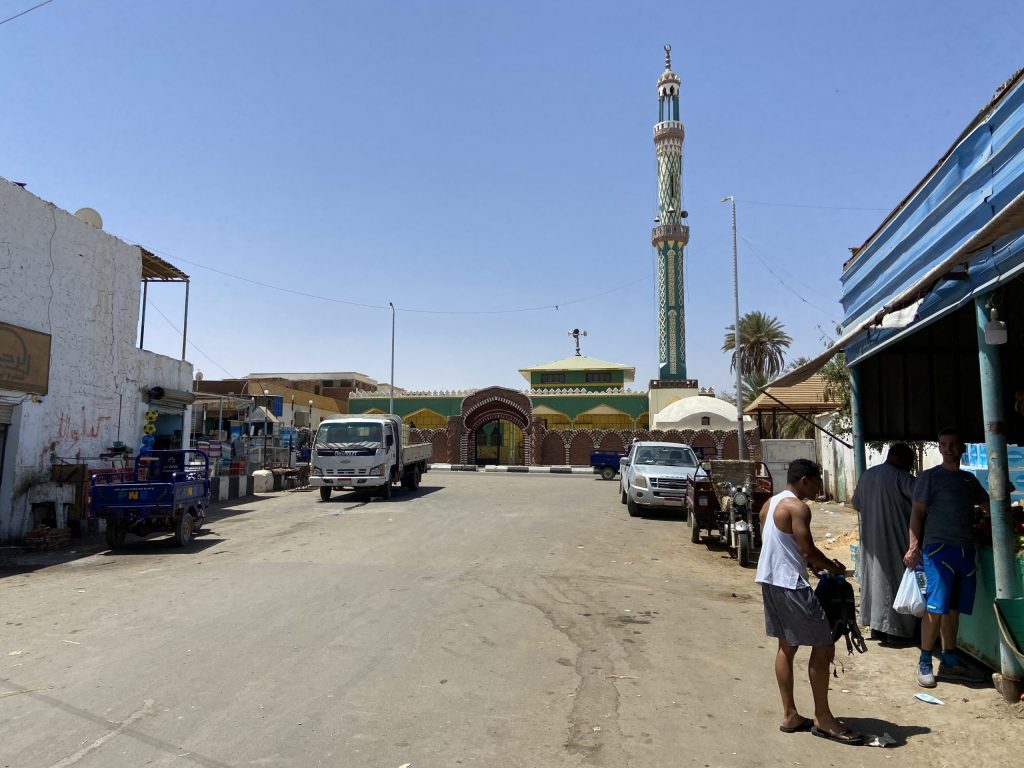
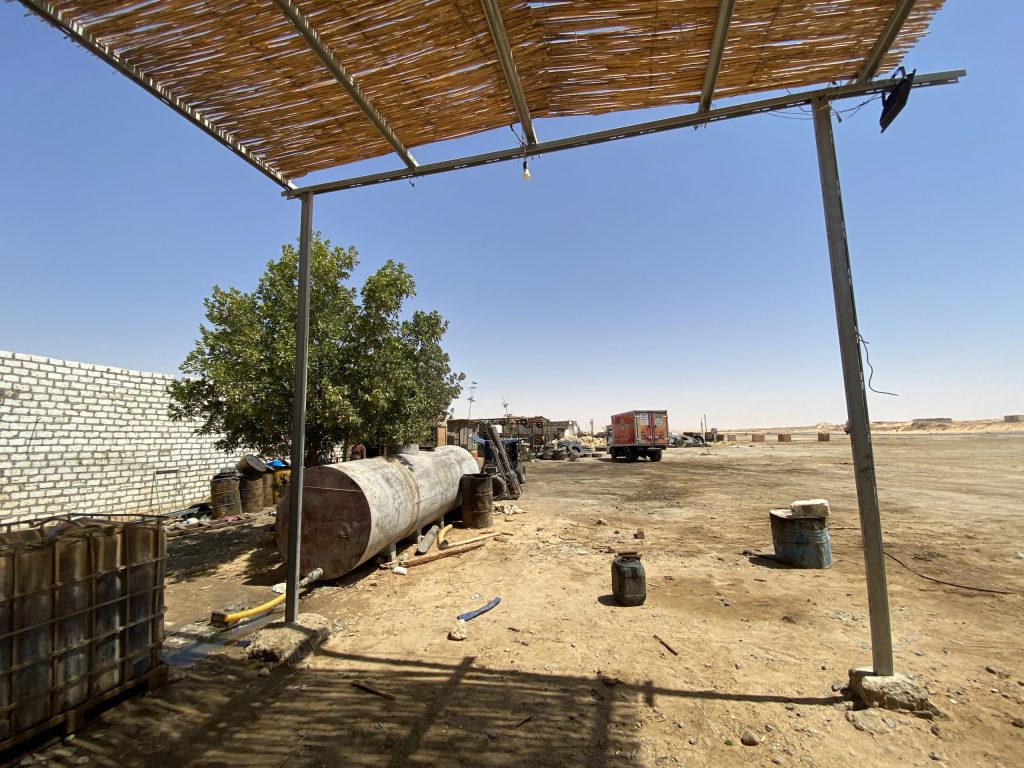
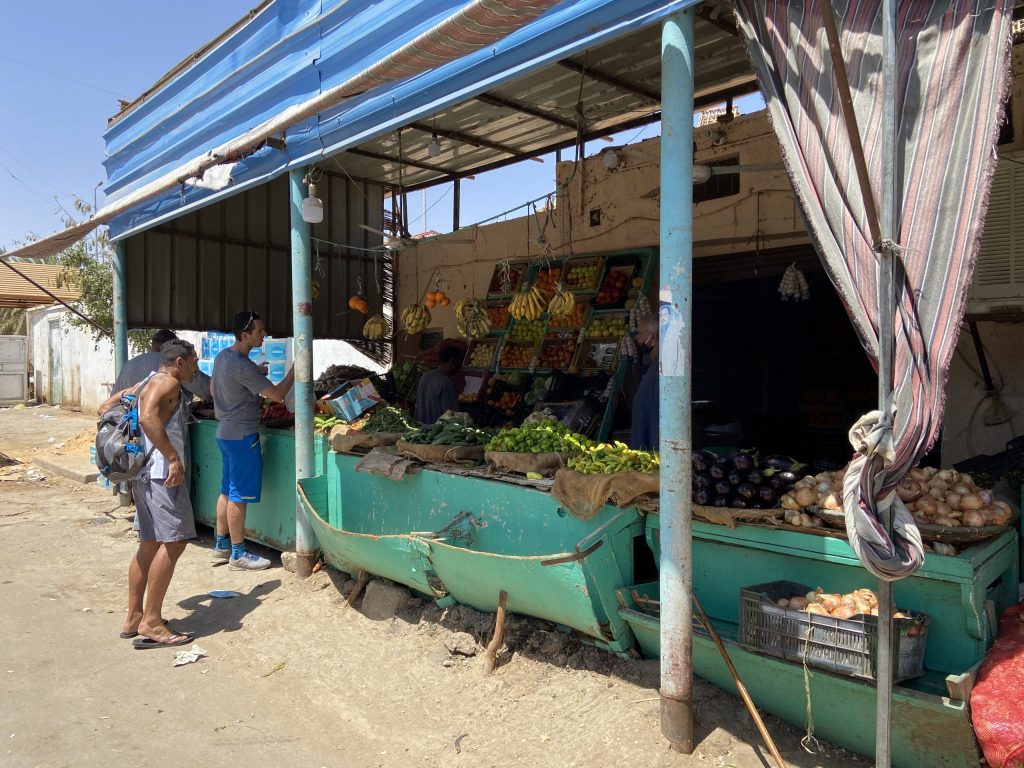
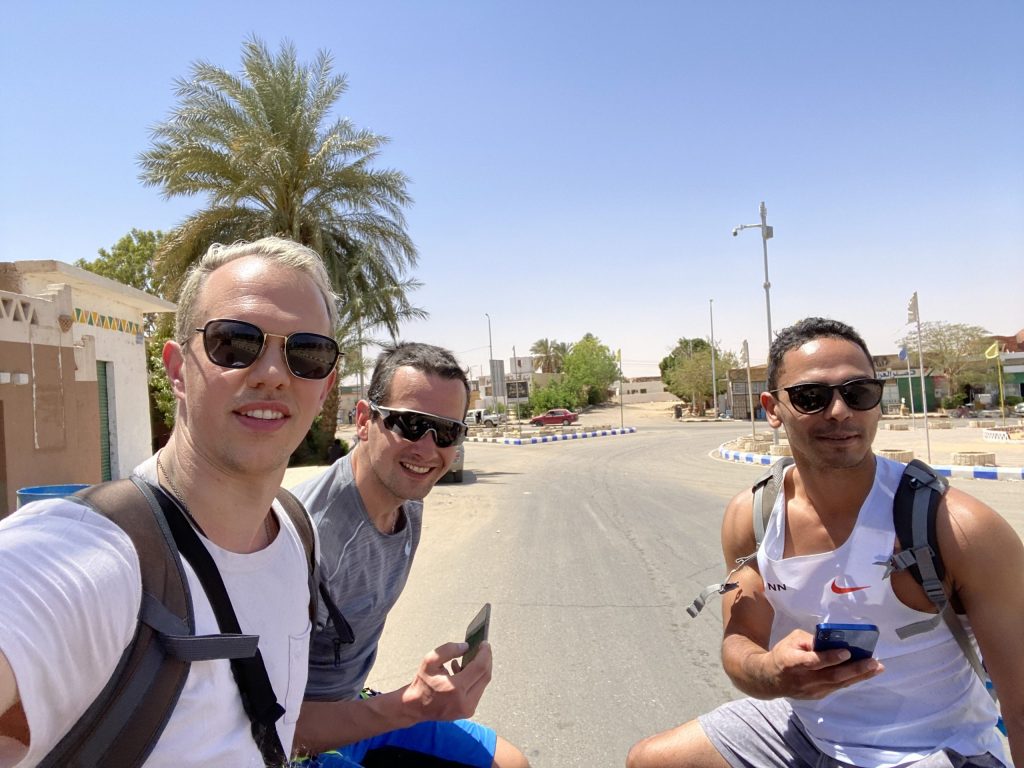
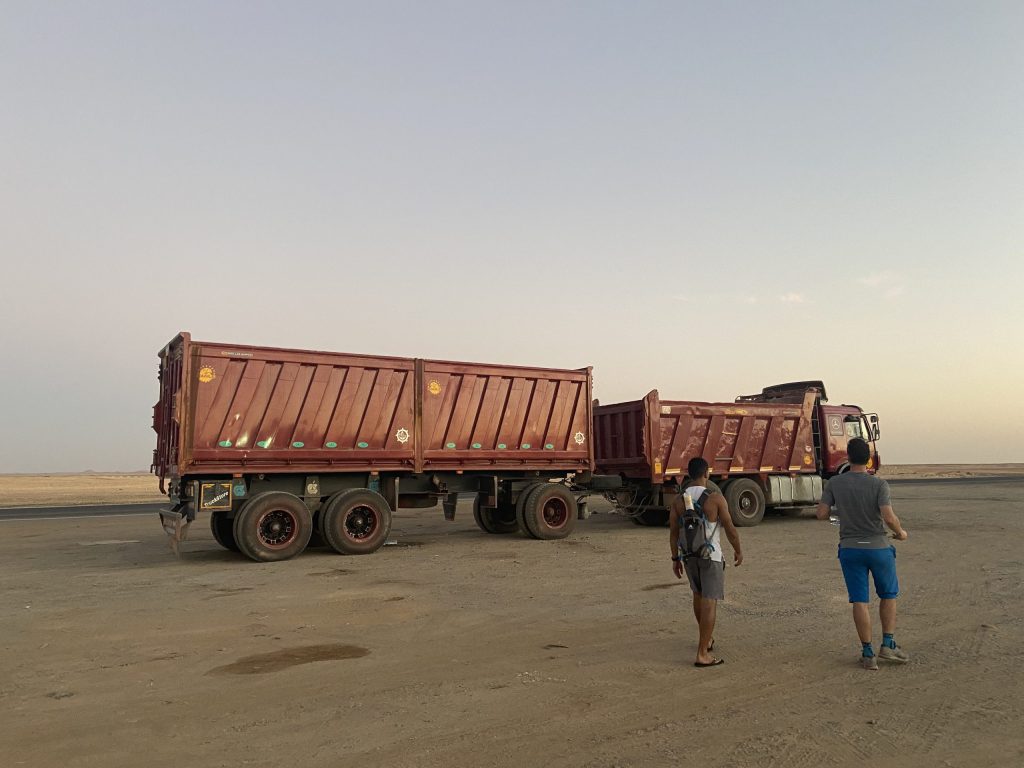
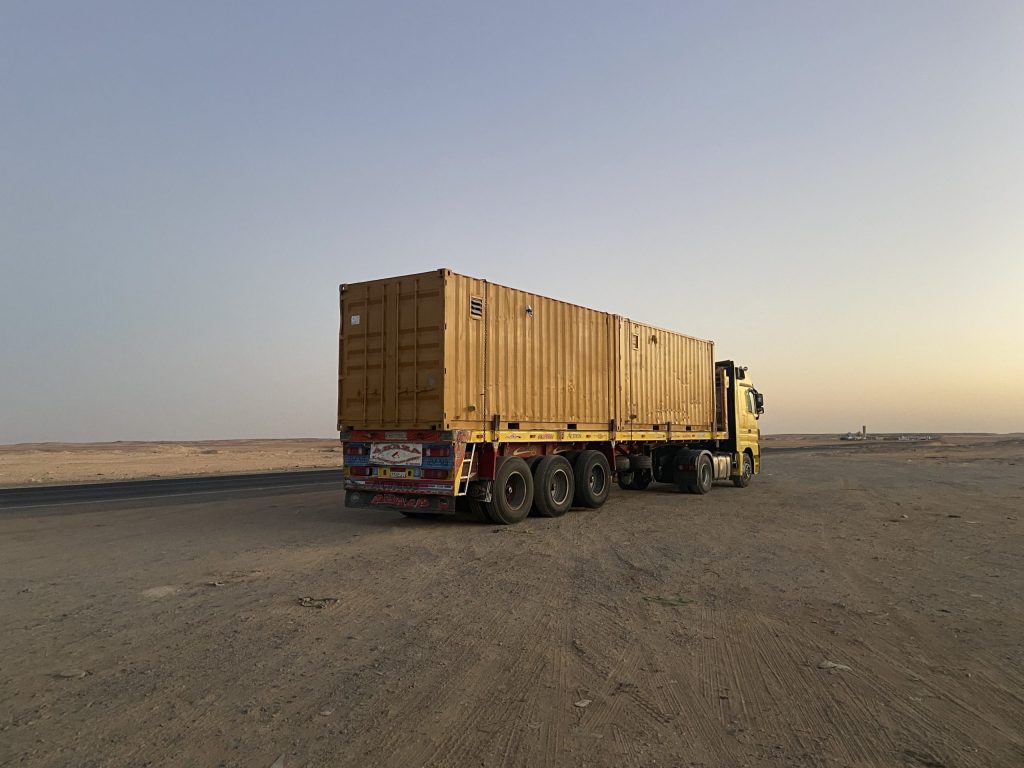
Days 6 to 8 : Luxor
Being already a big fan of public transport the next day I headed towards the Aswan train station to catch the 8 o’clock train to Luxor. At the windows it is practically impossible to get a rush hour ticket, since everyone sneaks in all the time and since you don’t speak Arabic they ignore you. So if you see that you are going to miss the train, go to the platform and get on the train directly and pay the conductor. It cost me 100 LE, I think the reviewer ripped me off, but what are we going to do?
Cruising the Nile, Felucca or going on your own?
Many travelers make the journey Aswan – Luxor by cruise with stops in Edfu and Kom Ombo. Here I leave it up to each of you how you want to organize your trip. The reason why I did not do it is because I made great friends along the way with different plans and which I liked and because I do not like the type of tour trip with which you stop every few hours and follow the guide in a group of forty other people. In addition, the flexibility in this type of trip is practically nil. An alternative is the Felucca (sailing boat, traditional in the region), which I did not do, but I would have liked to do it for a day, the prices are usually around 650 LE per person per day.
Luxor is probably the historical epicenter of Egypt, most of the most imposing tombs and temples are found here and it is that Luxor was one of the great capitals of the Egyptian civilization.
After five days of intense visiting I was craving a bit of relax, so after resting a bit at the hostel and meeting the owners (a charm, more info where to stay) and eating with them on their terrace I decided to head towards the temple of Karnak and Luxor.
The first one is about 45 minutes walk from the station area (it can be done on foot perfectly even if it is hot). Karnak is an imposing temple consisting of several rooms and sub-temples. Just as Abu Simbel stands out for the spectacularity of its four 33-meter statues, Karnak stands out for its tall pavilions and labyrinths of Egyptian columns. Between heat stroke and heat stroke I had the opportunity to rest in the shade and meet the director of the temple, just that day they inaugurated a new area and in the afternoon they had a private visit for the minister of antiquities, press and other personalities.
The second stop of the day was the temple of Luxor, the peculiarity of this is that it closes at 9 pm which gives the opportunity to visit it at night. It is one of the few temples that you can visit this late, so I recommend setting aside a little time to see it at dusk. Both Luxor and Karnak temples are connected by a road with hundreds of sphinxes, they are still working on their reconstruction.






In the evening we went to dinner with a friend at Sofra, one of the few good restaurants that I was able to find in Luxor. After 5-6 days eating street food it is good to sit down and relax in a good restaurant. Prices range from 150-200 LE for main, entree and drink. It is not expensive for western prices, but in Egypt it is somewhat out of budget.
The next day I spent part of the morning welcoming my friends who were arriving from Aswan. When they were installed like everyone else wanted to see different things, I went on my own to the westbank. There are many ways to visit the westbank of Luxor, either with a private driver, tour or the craziest by bike (crazy because it was 40ºC in the shade.
Without hesitation I opted for the third option. You can cross the Nile with a ferry for 5 LE in front of the Luxor museum, you will simply have to avoid a few vendors who will want you to get on their boat to cross to the other side. When you get to the other side and go up a small hill you will find a couple of shops where you can rent your bike, I rented one for 50 LE for the whole day. Take a lot of water, as it is difficult to find places to stop to buy. The tour can last about 4 hours and is not easy due to the terrible heat.
The simplest route is the following. Head west for about 15 minutes, your first stop will be the Colossus of Mennon, up here all very easy, since the road was flat and you probably have the breeze in your favor. The second stop is the farthest of all the Valley of the Kings, an imposing funerary complex excavated in the 240 LE mountain, with the entrance you can access three tombs, if you want to enter the Tuthankamon you will have to pay a supplement. My third stop was the temple of Hatshepshut 140 LE, much easier than reaching the Valley of the Kings because the road goes down almost all the time hehehe … To tell the truth I expected much more from Hatshepshut, and the temple is practically what you see from the outside, there is not much else to see.
I could have continued with Ramessseum and the Valley of the Queens, but I was very tired and decided to discard it, however I ended up visiting it the next day.
Egypt, being a Muslim country, is not a country with a lot of parties, although the big cities do not rest at any time and there is always movement in the streets, it is difficult to find places to go out so the number 1 option is always music and beers in the hostel and we did that same night.
Personally, I would not extend the visit to Luxor more than two days, although we had a great PLAN prepared that we could not do and the fact is that the third day in Luxor he woke up with a lot of wind and we could not do the balloon ride to see the sunrise. We had to resign ourselves and return to the hostel at 6 in the morning.
Even so, in the morning I had the opportunity to accompany a YouTuber friend who was doing a report on Egypt, we went to the Valley of the Queens and he told us all about its history. Here rests what was one of the most important queens of all Egypt, Nefertari, the wife of the great pharaoh Ramses.
Days 9 to 11: Dahab
Dahab is a place that would not leave me indifferent. Of course, to get there, a litmus test awaited us. Nothing more and nothing less than a 20-hour bus ride from Luxor to Dahab. Google says that it is 13 hours 40 minutes, that would be the case if the bus did not stop every 30 minutes either to go to the bathroom, drop off or pick someone up or stop at one of its countless police checkpoints. There was an occasion that we were stopping every 17 minutes up to four times in a row. The Luxor to Dahab bus leaves at 5, 6 and 8 pm from Luxor station and costs 330 LE. We did not go by plane because there were no places left.







As with everything in life, it is very important to get the place where you are staying right. In this case, after my experience, I can recommend two specific places: Elrayga Camp and Seven Heaven Hostel. Dahab has a different vibe to the rest of Egypt, perfect for diving, wind sports and adventure.
- Diving: The Red Sea is one of the best places in the world for diving. In my case, I took the opportunity to get my PADI with Scuba Seekers. The corals are spectacular, very abundant, in very good condition and with beautiful colors. However the marine life is a little poorer, at least in Dahab. I understand that Marsa Alam is a better spot.
- Blue Hole: As the name suggests, Blue Hole, it is a 113 meter cave on the seashore, about a 15 minute drive from Dahab. It is a natural park and you have to pay an entrance fee of 80 LE. Perfect for scuba diving and snorkelling, as its corals are very close to the surface.
- Dahab Lagoon: The paradise for lovers of wind sports. Kitesurfers and windsurfers from all over the world come together in this small town on the Gulf of Aqaba. Strong gusts of wind and moderate waves make it a perfect place to start these sports.
There are many more activities to do that in my case I did not, but I can recommend first-hand, Monastery of Santa Caterina, Nuweeiba, Taba and Abu Galoum.
But what makes Dahab unique is its good vibes, people wanting to join in on the plans, night and day entertainment. After three days of being in Dahab you will begin to feel like a local, you will meet all the people on the street and you will feel as if you have lived your whole life there. In my case I was going to stay four days and ended up staying two weeks.

Day 12: Cairo
With great sadness after two weeks in Dahab it was my third night transport of the trip back to Cairo. You can use GoBus Mini, it leaves at 1pm and 11pm it costs 280 LE, but it is much faster than the conventional bus, that does take warm clothes if you don’t want to get sick.
The last day in Cairo I spent visiting the Egyptian Museum, the Citadel and buying some souvenirs back home.
Daily budget for backpacking Egypt
Egypt is a surprisingly cheap country compared to what I had preconceived. Many times less developed countries are less accessible and you need to use much more private transport depending on which trips and that raises the cost significantly. In addition to being going into museums, temples and doing activities all day. However, you can do practically everything for about € 30- € 35 a day.
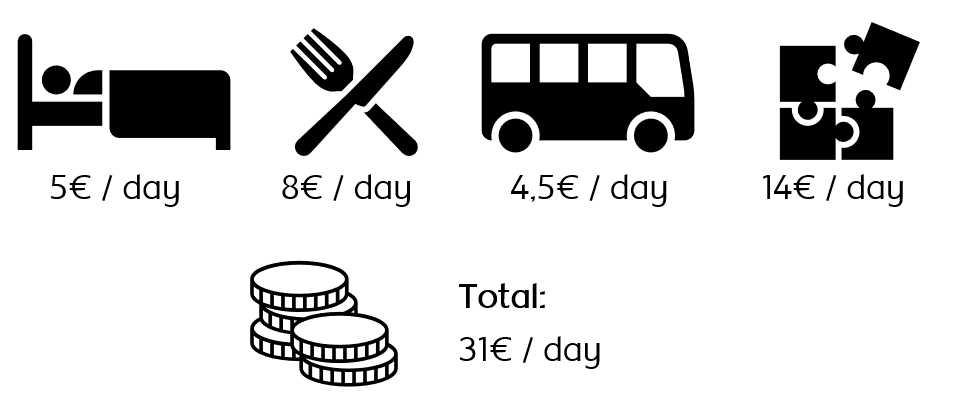
In no case have I paid more than 100 LE in my entire trip for accommodation. They are usually backpackers hostels and in most cases (with some exceptions) the infrastructure is usually quite good. In many cases they include breakfast. Transportation is usually around € 5 a day and is that either by trains, buses, uber / taxi or tuk-tuk you will need it in one way or another every day, remember to negotiate the price when using a taxi or tuk-tuk
As far as food is concerned, I always try to alternate streetfood with restaurants and this time he has left me an average of € 8 a day taking into account that many days I had breakfast in a restaurant so not bad.
Undoubtedly, the highest item of expenses is leisure, either because of the price of alcoholic beverages, which is usually expensive because of the place it is or because every day you will be entering temples and doing activities. In my case, he took 50% of the budget with about € 15 a day (with student meat and without being at all).
Where to stay in Egypt
I rarely have as much success in finding accommodation as in this trip, I stayed in four different cities (if we do not count buses and night trains) and the four chosen accommodations were a total success.
- Holy Sheet Hostel // Cairo: If I don’t misunderstand the cheapest hostel in the city, for 100 LE (€ 5) you have accommodation and breakfast included. Wherever you go in Egypt if you know someone who has passed through Cairo, has stayed at Holy Sheet. The staff is great, very attentive and the facilities are 10. If you travel alone you will have the opportunity to meet a lot of people.
- Seko Kato House // Aswan (Elephantine): As I mentioned earlier, if you go to Aswan you have to stay at Elephantine. Seko Kato is a guesthouse for about 15 people, Seko and her family are super attentive and even usually prepare free dinner for their guests from time to time (I was privileged). Backpacker environment, ideal for meeting people and giving that more local touch to your trip.
- Bob Marley Sherif Hostel // Luxor: Watch out! There are two Bob Marley Hostel in Luxor. Although the facilities are not the best and it is a bit left. Sayed and his family are unbeatable guests. It is usually quite busy and they will help you with local tips. Although they can be a bit insistent when it comes to selling you a tour.
- Elrayga Camp // Dahab: What to say about what was my home for 12 days. Enough statement to keep an eye on it. A relatively new camp (2 years) but with an excellent vibe, it has a pleasant patio where you will always find someone to chat with at all hours and who will surely sign up to any plan. Located less than a minute from the promenade. Although you can find somewhere relatively cheaper you can hardly beat Elrayga’s good backpacker vibe. There are dorms, private rooms and glamping.
What to do in Egypt if you have more time
The options are endless, but I leave you a short list:
- Siwa Oasis: Although I have received feedback of all kinds, most people agree that it is worth a visit. It is an oasis in the middle of the desert with waters that claim to be healing. You can do many activities related to the desert around it.
- Kom Ombo and Edfu: Although less interesting than its neighbors Luxor and Aswan, it is an obligatory stop for the cruises that go down the Nile. There is one of the largest temples in Egypt, the Temple of Horus. Although not essential, it will depend on the dose of Egyptian history you want to take on.
- Hurghada and Marsa Alam: For fans of scuba diving and live aboard diving. They are together with Dahab the best places for diving, Marsa Alam more secluded and with better cared for seabed and Hurghada with mass tourism and much more crowded.


